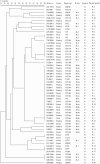Epidemiological characteristics of Salmonella Typhimurium isolated from animals and feed in Poland
- PMID: 16409666
- PMCID: PMC2870369
- DOI: 10.1017/S0950268805004838
Epidemiological characteristics of Salmonella Typhimurium isolated from animals and feed in Poland
Abstract
Fifty-seven Salmonella Typhimurium strains isolated from poultry, swine and animal feed in Poland during the years 1979-1998 and 2000-2002 were analysed with conventional and molecular techniques. Antimicrobial resistance as well as multiresistance was found, respectively, in 80.1% and 56.1% of the isolates and most frequently among isolates from 2000-2002. Of several phage types noted, DT104 was prevalent among poultry, swine and feed isolates. DT104, U302 and non-typable strains had a multiple resistant profile (ACSSuT) due to the presence of class I integrons. Pulse-field gel electrophoresis of XbaI and BlnI digest showed high genomic similarity between the strains and confirmed clonal spread of S. Typhimurium infections. Plasmid profiling allowed further differentiation of the strains. We have, therefore, confirmed the appearance of S. Typhimurium DT104 showing genome integrated integron-mediated antimicrobial resistance in Poland. These findings are significant for public and animal health risks and document the dissemination of DT104 epidemic strains into new geographical regions.
Figures
Similar articles
-
Characterization of Salmonella enterica serovar typhimurium DT104 isolated from Denmark and comparison with isolates from Europe and the United States.J Clin Microbiol. 2000 Apr;38(4):1581-6. doi: 10.1128/JCM.38.4.1581-1586.2000. J Clin Microbiol. 2000. PMID: 10747147 Free PMC article.
-
Detection of multidrug-resistant Salmonella enterica serovar typhimurium phage types DT102, DT104, and U302 by multiplex PCR.J Clin Microbiol. 2006 Jul;44(7):2354-8. doi: 10.1128/JCM.00171-06. J Clin Microbiol. 2006. PMID: 16825349 Free PMC article.
-
Characterization of integron mediated antimicrobial resistance in Salmonella isolated from diseased swine.Can J Vet Res. 2003 Jan;67(1):39-47. Can J Vet Res. 2003. PMID: 12528827 Free PMC article.
-
Molecular characterization, spread and evolution of multidrug resistance in Salmonella enterica typhimurium DT104.Vet Res. 2001 May-Aug;32(3-4):301-10. doi: 10.1051/vetres:2001126. Vet Res. 2001. PMID: 11432421 Review.
-
Multi-resistant Salmonella Typhimurium DT104--implications for animal industries and the veterinary profession.Aust Vet J. 1999 Mar;77(3):170-1. doi: 10.1111/j.1751-0813.1999.tb11227.x. Aust Vet J. 1999. PMID: 10197245 Review. No abstract available.
Cited by
-
Long-term dissemination of CTX-M-5-producing hypermutable Salmonella enterica serovar typhimurium sequence type 328 strains in Russia, Belarus, and Kazakhstan.Antimicrob Agents Chemother. 2014 Sep;58(9):5202-10. doi: 10.1128/AAC.02506-14. Epub 2014 Jun 23. Antimicrob Agents Chemother. 2014. PMID: 24957829 Free PMC article.
-
The Protective Effect of E. faecium on S. typhimurium Infection Induced Damage to Intestinal Mucosa.Front Vet Sci. 2021 Oct 15;8:740424. doi: 10.3389/fvets.2021.740424. eCollection 2021. Front Vet Sci. 2021. PMID: 34722703 Free PMC article.
-
Development of rapid detection and genetic characterization of salmonella in poultry breeder feeds.Sensors (Basel). 2009;9(7):5308-23. doi: 10.3390/s90705308. Epub 2009 Jul 6. Sensors (Basel). 2009. PMID: 22346699 Free PMC article.
References
-
- Poppe C, Ziebell K, Martin L, Allen K. Diversity in antimicrobial resistance and other characteristics among Salmonella Typhimurium DT104 isolates. Microb Drug Resist. 2002;8:107–122. - PubMed
-
- Sandvang D, Jensen LB, Baggesen DL, Baloda SB. Persistence of a Salmonella enterica serotype Typhimurium clone in Danish pig production units and farmhouse environment studied by pulsed field gel electro-phoresis (PFGE) FEMS Microbiol Lett. 2000;187:21–25. - PubMed
MeSH terms
LinkOut - more resources
Full Text Sources


